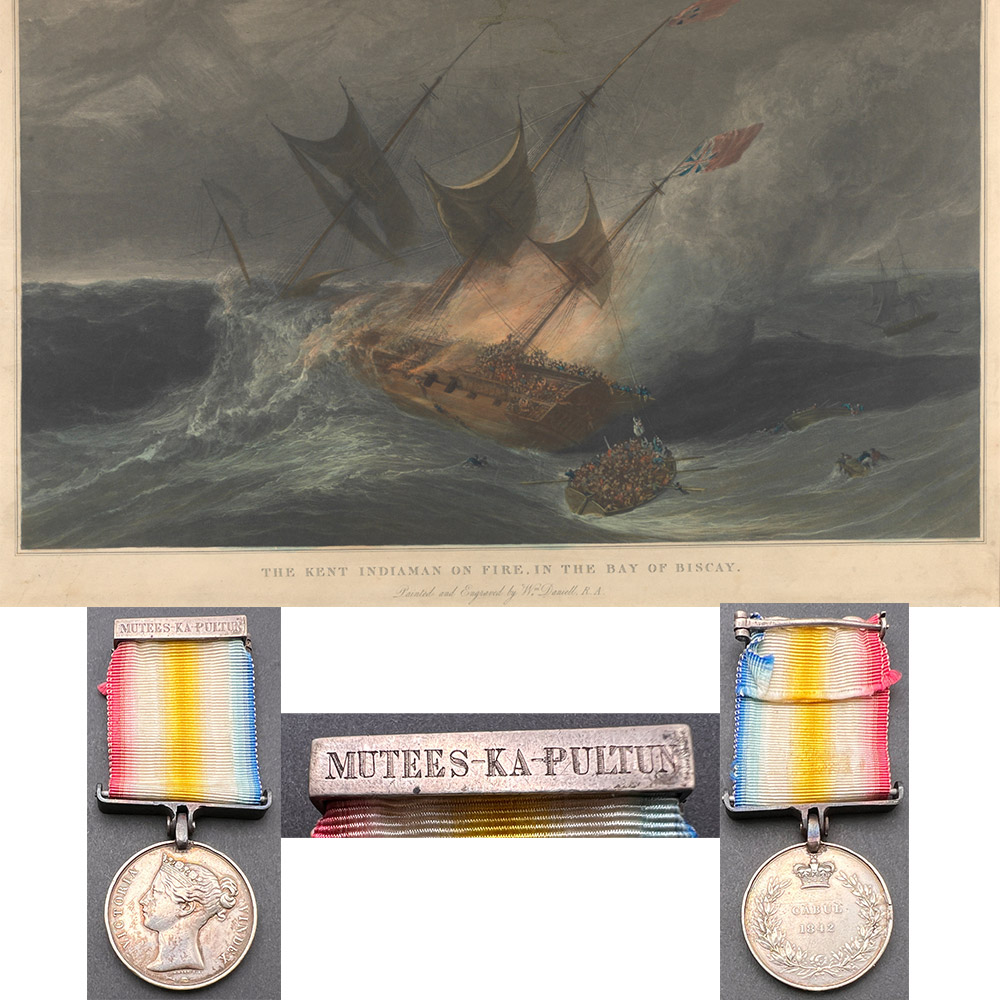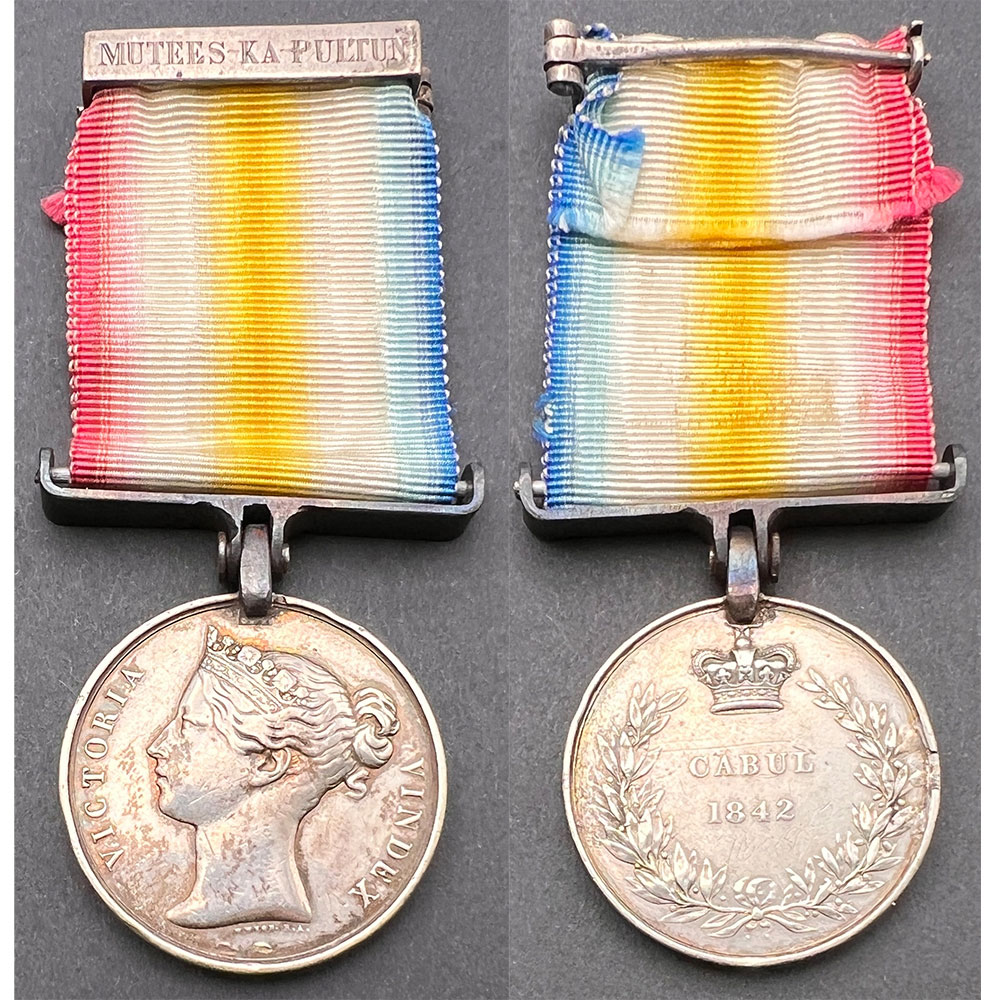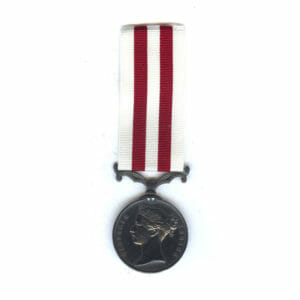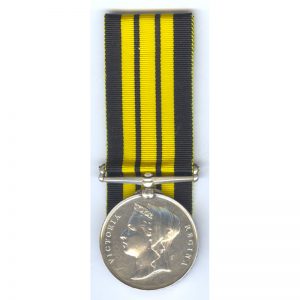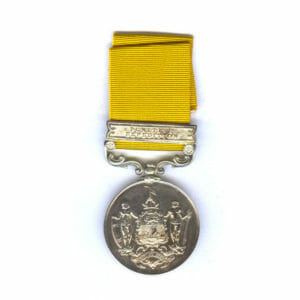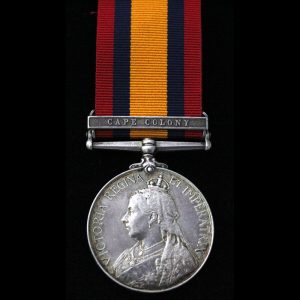Description
Cabul 1842, 333 Private Wililam Flynn, 31st Regiment of Foot. With copy service papers and suspended from customised ribbon brooch engraved ‘Mutees-Ka-Pultun”
One of the original men who went over to India and survived the Burning of the East Indiaman Kent during 1825, and fought in the Afghan War 17 years into his service in the “East Indies”, where having seen much action at Mazeena and Tazeen he was also seriously hurt.
Engraved in correct regimental style: “* No 333 William Flynn Pt H.M.s 31st Regt. *”
Traces of having been brooch mounted on the reverse but skilfully removed many years ago (ex Spink 1953 in the current state)
Provenance, ex Seaby Coin & Medal Bulletin, April 1953, sold for 52/6.
Subject of an article in the Seaby’s Coin and Medal Bulletin regarding the unusual bar which the medal is suspended from.
A snippet reads: “MUTEES-KA-PULTUN, A correspondent draws attention to an interesting feature of a Medal F6900 offered in the April Bulettin – a Cabul to William Flynn, 31st Regt, with an unofficially ribbon bar inscribed “Mutees-ka-Pultun”, “Pultun means Regiment and “Ka” means…”
We don’t have a copy of the Circular to expand on this but “Mutees-Ka-Pultun” was the name of the 48th Regiment of Native Infantry they fought also in Afghanistan and at Ghuznee, the ribbon is still somewhat of a mystery.
William Flynn, was born during 1805 in Karrah, Naas, County Kildare, Ireland.
He had first enlisted into the 31st Regiment of Foot on 5th January 1824 aged 19.
He would go on to serve his 20 years 270 days in the Army, of which 18 years were spent “In the East Indies”.
His conduct noting the medal reads:
“His character is very good, his name only appears 3 times in the defaulter’s book, he wears 1 good conduct badge, and is entitled to a second, he also wears a medal for service in Affghanistan.”
His service are also noted on his papers:
“He served in the Campaign of 1841 in Afghanistan, and was present at MAZEEN and TAZEEN
His left leg was seriously hurt at the JOTA KHYBAR by the Large Gun, the Ghazee running him against the bank.
He was in the Burning of the Kent East Indiaman when first at sea on 1st March 1825.”
This last part regards the Burning of the Kent “In 1824 the regiment were ordered to India under Colonel Pearson and Major McGrrego, some 54 men on the regiment died on 1st March 1825 when their transport, the East Indiaman Kent caught fire in the Bay of Biscay. One woman and 20 children affiliated with the regiment also died. The remainder of the 20 Officers, 344 Soldiers, 43 women and 66 children, belonging to the regiment that had embarked on the vessel were rescued.
As the official record expresses it: “In the midst of dangers against which it seemed hopeless to struggle-at a time when no aid appeared, and passively to die was all that remained-each man displayed the manly resignation, the ready obedience, and the unfailing discipline characteristics of a good soldier.” “
Action at Mazeena (Mazeen), 24 & 26th July 1842.
The 31st Regiment were the only British regiment present, along side the 33rd and 53rd Native Infantry the Ferris Corps of Jeailchis and some of the 1st Light Cavalry, alongside some guns and 50 Sappers and Miners.
Part of the actions fought in the “Raid on Shinwaree Valley”, Following a skirmish by the reconnoitring party on 24th July, on the 26th an attack was launched.
“At a place named Mazeena the tribes made some show of resistance, but the steady gallantry of her Majesty’s 31st Regiment of of their sepoy comrades was not to be withstood, the shells from Abbot’s howitzers were irresistible, and so Monteith effectually beat down the opposition of the Shinwarrees. This was on the 26th of July.”
Battle of Tezeen (Tezin or Tazeen), 12 & 13th September 1842.
At Tezin-e Khas in Afghanistan, as part of Major General Pollocks “Avenging Army” William fought against the afghan tribesmen and were victorious a brief account reads:
“Both brigades of Pollock’s army re-united at the valley of Tezeen where they were met by Akbar Khan and his forces from Kabul. The Afghans held the heights around the valley but a series of sorties drove them back and this victory left the way clear for the advance to Kabul.”
